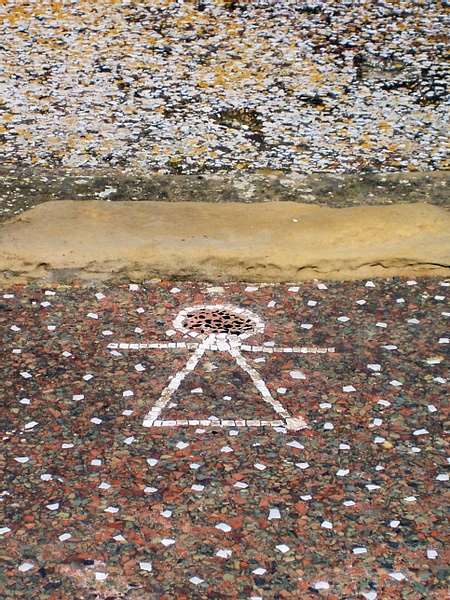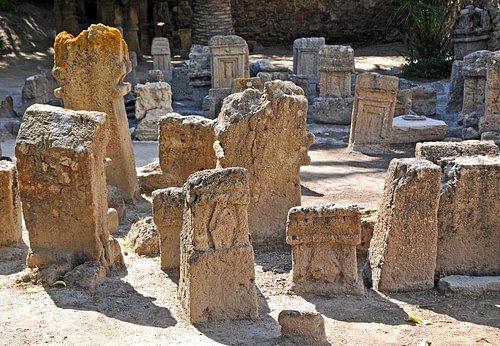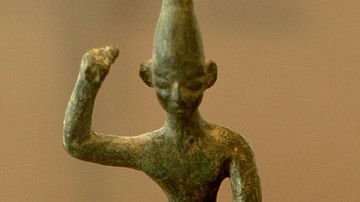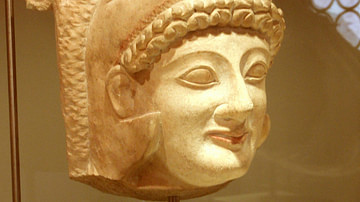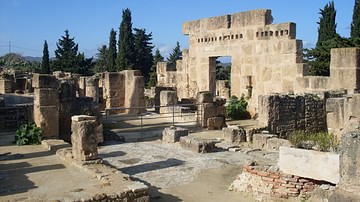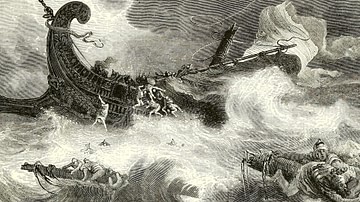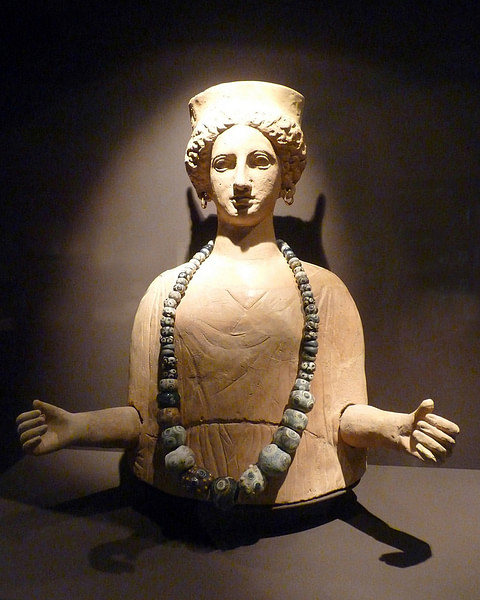
Carthage was founded by the Phoenician city of Tyre in the 9th century BCE, and along with many other cultural practices, the city adopted aspects of the religion of its founding fathers. Polytheistic in nature, such important Phoenician gods as Melqart and Baal were worshipped in the colony alongside new ones such as Tanit. These, in turn, were spread to new Punic colonies around the ancient Mediterranean while in the other direction gods from neighbouring cultures were incorporated into the Carthaginian pantheon. Temples were built in their honour, ceremonies were overseen by a priestly class, sacrifices were made to appease them, and their imagery appeared on ships, coins, and in the arts.
The Gods
Most Carthaginian gods were inherited from the Phoenicians, but these were adapted, and their names and functions evolved over time. The most important Carthaginian deity was Melqart, patron and protector of the city of Tyre and perhaps given a similar role in early Carthage. Indeed, the colonists were obliged to send annual tribute - one-tenth of their annual profits - to the temple of Melqart at Tyre for the first few centuries of the colony's existence. In the 3rd century BCE the influential Barcid clan of Carthage were particularly keen worshippers of Melqart. Hannibal famously swore an oath to the god in 237 BCE when, aged 9, he stated that he would forever be the enemy of Rome. Hannibal, too, was not the only Carthaginian general that deified himself and took on the appearance of the god. The Greeks identified Melqart with their own hero Hercules, and a cult of Melqart-Hercules spread around the Mediterranean.
Baal Hammon ('lord of the altars of incense') was another important god, inspired by the Baal who was supreme god at the Phoenician city of Sidon. Baal had many other incarnations, or perhaps even separate deities under that name: Baal Iddir, Baal Marqod, Baal Oz, Baal Qarnem, Baal Sapon, and Baal Shamin. Historians, such is the lack of clarity on the specifics of Phoenician and Carthaginian gods, continue to discuss his association or even equivalence to Melqart and the Phoenician god El.
Similarly, the Phoenician gods Eshmun (an equivalent of Adonis but also identified as Asclepius by the Greeks, suggesting he had an association with healing at Carthage), Reshef (the god of fire and lightning, linked to Apollo by the Greeks), and Rasap (associated with warfare) were worshipped at Carthage but again with slightly different connotations such as Reshef (a form of Rasap) and Shadrap (associated with snakes and healing). Less important Phoenician gods surviving in Punic religion included Hawot (god of the dead), Hudis (the new moon), Kese (the full moon), Kusor/Kusorit (god/goddess of intelligence), and Semes (the sun goddess).
One of the most important Punic deities that were not worshipped in Phoenicia was Tanit (Tnt), although she may have been considered an attendant of Astarte there. Tanit came to prominence only from the 5th century BCE at Carthage, but she would eventually supersede Melqart and Baal Hammon in importance. She represented a mother goddess, life, and fertility. Strongly linked to Baal and considered the consort of Baal Hammon, she was commonly referred to as 'Tanit face of Baal' (Tnt pn B'l) and represented in inscriptions, mosaics, pottery, and stelae as a symbol (a triangle with a straight line and circle above it) seemingly representing a stylised female figure with arms outstretched. No other symbols are known of the other Carthaginian gods. Tanit was also associated with the palm tree, dove, the moon, fish, and pomegranate, all of which appear with her on Carthaginian coins and stelae dedicated to her. In later sculpture, she is most often portrayed with a lion's head and wings, and a second symbol of her is the bottle shape prevalent on votive stelae.
Finally, gods were adopted and adapted from the Greek pantheon following the increasing Hellenization of Carthage from the 4th century BCE. Demeter and Persephone (Kore) were especially popular and were incorporated into the Punic pantheon following a series of military disasters which the Carthaginians ascribed to their unwise destruction of the goddesses' temple at Syracuse in 396 BCE. High ranking priests and priestesses were specifically assigned to serve the goddesses. Another foreign import was Isis, who had a temple in the city. One of the goddess' priestesses is depicted on a stunning marble sarcophagus lid from the St. Monique tomb. The use of Egyptian-made and home-copied amulets was widespread at Carthage judging by their abundance in tombs.
The Priests
In the founding legend of Carthage, Dido (Elissa), the queen who fled from Tyre, picked up the High priest of Astarte in Cyprus on her way to North Africa, promising him that he and his descendants would hold the position of High Priest in the new city. This was the first of a priestly class at the city. The elite class of Carthage dominated the important religious posts. The head of the priests (rb khnm) was also a member of the Senate and the influential Council of 104. A committee of 10 senators was responsible for state religious matters. Priests would have enjoyed a high status but lived an austere life, symbolised by their distinctive shaved heads. Priests made themselves even more distinguished by painting themselves with red ochre during ceremonies. The majority of the city's religious positions seem to have been hereditary. Inscriptions inform us that a chief priest was responsible for a particular temple and assisted by a lower category of priests (khnm). There were female priests, but once again, the details of initiation and duties of the priestly class remain unknown. Priests may have controlled education, of which we know very little, and also the libraries we know existed at the time of Carthage's destruction in 146 BCE.
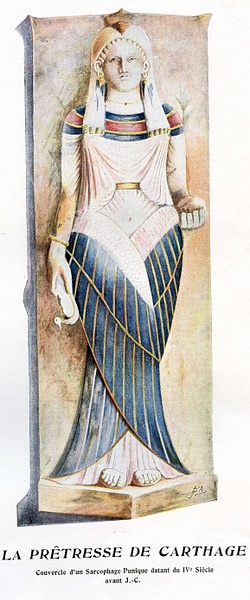
The Temples
Inscriptions on Punic stelae describe many temples to many different deities at Carthage, but unfortunately, very little remains of them exist in the archaeological record due to the destruction of the city by the Romans at the end of the Third Punic War in 146 BCE. There were probably as many temples at Carthage as at the contemporary cities of Rome and Athens. We can imagine they were similar to Phoenician temples such as Solomon's described in the Bible as designed by Phoenicians and Melqart's temple at Tyre, described by Herodotus. These had two large columns, one either side of the entrance which led to three chambers within which was not a representation of the god but a large bronze bowl with an eternal flame.
It was outside the temples that ceremonies were carried out such as prayers, burning incense, and making offerings to the gods at a specially dedicated altar. These could take the form of the pouring of libations, food offerings, flowers, animal sacrifice (bulls, lambs, poultry, birds etc.), and even human sacrifice (molk). We also know that temples were off-limits to women and pigs, although there were some priestesses who served certain deities and their temples. Religious ceremonies could also take place at natural features like rivers and springs as these were often held as sacred by the Carthaginians.
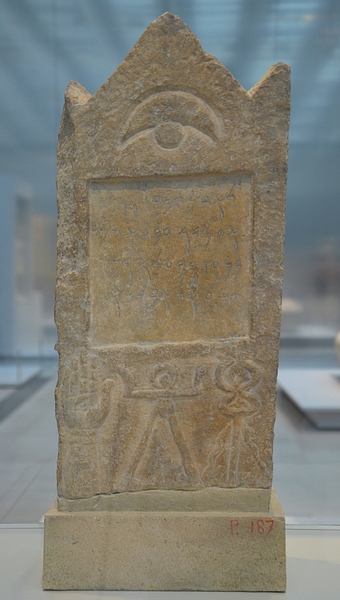
The Tophet
One of the rituals of the Phoenician and Punic religions was to sacrifice humans, especially children (but not only), according to ancient sources. The victims were killed by fire, although it is not clear precisely how. According to the ancient historians Clitarch and Diodorus, a hearth was set before a bronze statue of the god Baal (or El), who had outstretched arms on which the victim was placed before falling into the fire. They also mention the victims wearing a smiling mask to hide their tears from the god to whom they were being offered. The victim's ashes were then placed in an urn topped with a stone. The urns themselves were often recycled pots and jars from as far afield as Corinth and Egypt and so provide an interesting and valuable record of Mediterranean trade. From the 6th century BCE, stelae were dedicated to Baal or Tanit and placed on top of the urns instead of stones. Thousands of examples survive of these votive markers and are powerful evidence that the Carthaginian religion was practised by all levels of society. Some urns were buried in shaft tombs and the dedicated sacred open space for these urns was surrounded by walls and known as a tophet.
The tophet at Carthage was known as the 'precinct of Tanit' and located to the south of the city at Salammbo. It was first used in the 8th century BCE and continuously thereafter until the fall of Carthage in the Punic Wars. At its largest extent, it covered 6,000 square meters and has nine descending levels. There is a shrine area with an altar where the sacrifices were made.
In the ancient world, the Phoenicians and Carthaginians earned a bloody reputation for frequent child sacrifice, but some historians have questioned the scale of this practice. Many stelae have an inscription which describes a human blood sacrifice, but others describe the substitution of a sheep or lamb for a child. Further, on closer inspection, it is notable that all of the literary references to human sacrifice suggest that it was necessary only in times of great danger to the state such as wars, plagues, and natural disasters, and was not an everyday practice. Even in Phoenician/Punic mythology, where the god El sacrifices his son Ieud, it is to save his country from collapse. In another example, Diodorus describes the Carthaginian general Hamilcar sacrificing a child during the siege of Agrigento in the 5th century BCE when the defenders were suffering from a fatal outbreak of disease. Further, human sacrifices in ancient sources are almost always the children of rulers and the ruling class, as the gods, apparently, were not to be moved by the sacrifice of the common people.
Analysis of the remains found within the urns at Carthage reveals that, overall, 80% of the human remains are from newborn babies or foetuses. This is similar to the percentage at other tophets such as on Tharros. The exact cause of death is not possible to determine, but historian M. E. Aubet concludes the following,
...everything points to them dying of natural causes, at birth or a few weeks later. Although human sacrifice may have been practised, the high proportion of newborn babies in the tophets shows that these enclosures served as burial places for children who died at birth or had not reached the age of two. (252)
Aubet also notes that the cemeteries of Punic cities do not contain the remains of young children, suggesting that all children, no matter the cause of death, were buried within the tophet. Child sacrifice did occur at Carthage, as it did in many other ancient cultures, but the physical evidence of the scale of such a practice does not seem to match the long-held infamous reputation the Phoenicians and Carthaginians have suffered from since antiquity.
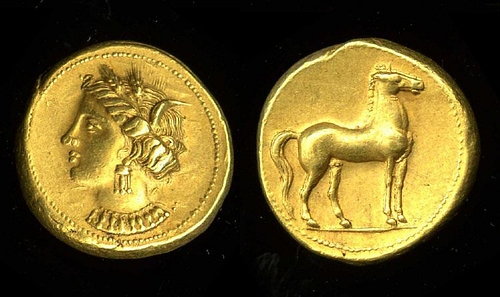
Conclusion
Our information on many of the details of the Punic religion is, then, incomplete due to a lack of contemporary sources from the Carthaginians themselves. The situation is made more complex by the sometimes indiscriminate use of Greek and Latin names by ancient writers of those cultures when describing Carthage's religious practices, not to mention their bias against foreign practices. No temples survive, no texts on the Punic mythology have come down to us, and we are left only with a number of inscribed stelae and certain art objects to piece together the details. Tombs have been a vital source of such objects, and the presence of votive offerings, day-to-day utensils, amulets, and masks to ward off evil spirits would suggest that the Carthaginians did believe in some sort of after-life. As with many other aspects of the Carthaginian religion, though, we do not know any precise details and we are left wondering what that life entailed or how a person could assure they ever got there. More certain is that the Carthaginian religion continued, beyond the Roman destruction of the city, to be practised, sometimes under different names, perhaps more clandestinely than previously, but very often at the same temple sites as before.
